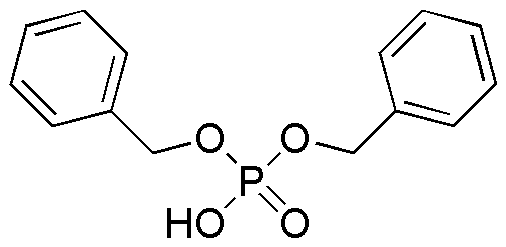Dibenzyl phosphate is widely utilized in research focused on:
- Organic Synthesis: It serves as a versatile reagent in organic chemistry, facilitating the formation of various organic compounds through phosphorylation reactions.
- Pharmaceutical Development: This compound is used in the synthesis of active pharmaceutical ingredients (APIs), enhancing the efficiency of drug formulation processes.
- Surface Coatings: Dibenzyl phosphate acts as a plasticizer in polymer formulations, improving flexibility and durability in coatings used in automotive and industrial applications.
- Biotechnology: It is employed in the preparation of enzyme substrates, aiding in biochemical assays and research, particularly in studying enzyme kinetics.
- Analytical Chemistry: The compound is utilized as a standard in chromatographic techniques, providing reliable benchmarks for the analysis of complex mixtures.
General Information
Properties
Safety and Regulations
Applications
Dibenzyl phosphate is widely utilized in research focused on:
- Organic Synthesis: It serves as a versatile reagent in organic chemistry, facilitating the formation of various organic compounds through phosphorylation reactions.
- Pharmaceutical Development: This compound is used in the synthesis of active pharmaceutical ingredients (APIs), enhancing the efficiency of drug formulation processes.
- Surface Coatings: Dibenzyl phosphate acts as a plasticizer in polymer formulations, improving flexibility and durability in coatings used in automotive and industrial applications.
- Biotechnology: It is employed in the preparation of enzyme substrates, aiding in biochemical assays and research, particularly in studying enzyme kinetics.
- Analytical Chemistry: The compound is utilized as a standard in chromatographic techniques, providing reliable benchmarks for the analysis of complex mixtures.
Documents
Safety Data Sheets (SDS)
The SDS provides comprehensive safety information on handling, storage, and disposal of the product.
Product Specification (PS)
The PS provides a comprehensive breakdown of the product’s properties, including chemical composition, physical state, purity, and storage requirements. It also details acceptable quality ranges and the product's intended applications.
Certificates of Analysis (COA)
Search for Certificates of Analysis (COA) by entering the products Lot Number. Lot and Batch Numbers can be found on a product’s label following the words ‘Lot’ or ‘Batch’.
*Catalog Number
*Lot Number
Certificates Of Origin (COO)
This COO confirms the country where the product was manufactured, and also details the materials and components used in it and whether it is derived from natural, synthetic, or other specific sources. This certificate may be required for customs, trade, and regulatory compliance.
*Catalog Number
*Lot Number
Safety Data Sheets (SDS)
The SDS provides comprehensive safety information on handling, storage, and disposal of the product.
DownloadProduct Specification (PS)
The PS provides a comprehensive breakdown of the product’s properties, including chemical composition, physical state, purity, and storage requirements. It also details acceptable quality ranges and the product's intended applications.
DownloadCertificates of Analysis (COA)
Search for Certificates of Analysis (COA) by entering the products Lot Number. Lot and Batch Numbers can be found on a product’s label following the words ‘Lot’ or ‘Batch’.
*Catalog Number
*Lot Number
Certificates Of Origin (COO)
This COO confirms the country where the product was manufactured, and also details the materials and components used in it and whether it is derived from natural, synthetic, or other specific sources. This certificate may be required for customs, trade, and regulatory compliance.


